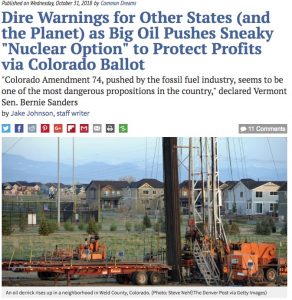I recently wrote about neighborhoods in and around Denver-Boulder trying to pass a modest proposition to keep fracking rigs a little farther away from their backyards. That vote failed in the November elections as the fracking industry piled on a mountain of money to make sure they could continue to drill along side backyards, schools, hospitals, and waterways. (You know, places that ought to matter to decent people!)
That’s, of course, not the end of the story. Phillip Doe reported in counterpunch that when the frackers are done they’re supposed to cap the wells so methane won’t leak out. But they don’t. This is where socialism comes in. But first, understand the basics of fracked natural gas wells– it’s a lot like shaking a soda can then popping the top. After the fizzing spew is over, a lot of soda sits in the can. Replace soda with natural gas and there you have frackers moving on for another spewing profit bonanza, leaving the public holding the can.
About half of Colorado’s 100,000 wells are closed and of them over 700 are “orphaned” or basically abandoned. Now, let’s start connecting some dots.
But not all is (financially) well in the industry. Fracking companies either in bankruptcy or heading toward that safehaven is the next “dot” to connect. In other words, with massive and unsustainable microeconomic debt who’s going to pay to cap these wells? $8.5 billion and likely more the public will pay. Maintenance on these caps will be required for decades. Who’ll pay for that?
Some of the public will also pay additional costs with their health! What bean-counters are factoring in that expense? Officially none, but even that venerable capitalist voice, Forbes, tells us fracking is bad for human health. Anywhere there’s a fracking operation, there’s a public health “dot.”
Let’s move on to another “dot,” this one a little closer to home. Duke Energy, like many of the electric utilities, boasts of cheap and plentiful natural gas. You can hear Duke’s PR man brag about it here. They invest heavily in natural gas combustion generation and make public claims that their “fuel source” is cheap. Really?
The next “dot?” When we do the solar financial modeling for nonprofit organizations, we have to compare their “business as usual” (grid supplied electricity) with solar. Utilities shift (i.e. hide) a lot of things under their “fixed cost.” You’ll see a part of your bill that you pay regardless of how many kilowatt hours you use. That makes it difficult get the full value from solar that is actually there. That shape-shifting isn’t done by the laws of nature; it’s done by corporations seeking to extract even more massive profit from the public.
In sum, this is another example of how private companies love socialism– when they offload their expenses and garbage on others in order to maximize profit. For an industry to say solar is expensive and that “conventional power” is cheap is simply crazy talk. Economists created a word (sounds so scientific, doesn’t it) that conveniently hides these costs– EXTERNALITIES. What a big linguistic rug to sweep all this under. It’s time for a wake-up call.
This fracking story may be far away in Colorado, but we need to connect these dots. Their effects land very close to home. Their backyard is my backyard. The effects span the globe since methane is a potent climate-destroying gas.